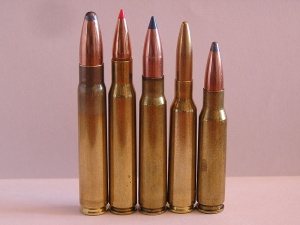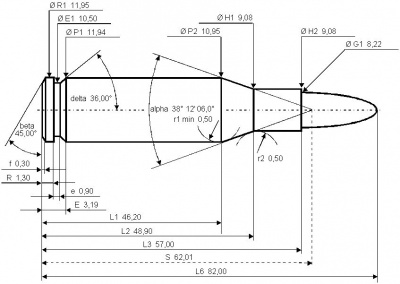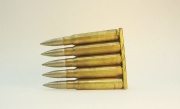7.92x57mm Mauser
| 7.92x57mm | |||||||||||||||||||
|---|---|---|---|---|---|---|---|---|---|---|---|---|---|---|---|---|---|---|---|

| |||||||||||||||||||
| From left to right 9.3x62mm, .30-06 Springfield, 7.92x57mm IS, 6.5x55mm and 7.62x51 mm cartridges | |||||||||||||||||||
| Type | Rifle | ||||||||||||||||||
| Country of Origin | German Empire | ||||||||||||||||||
| Specifications | |||||||||||||||||||
| Case Type | Rimless, bottleneck | ||||||||||||||||||
| Bullet Ø | 8.20 mm (0.323 in) | ||||||||||||||||||
| Neck Ø | 9.08 mm (0.357 in) | ||||||||||||||||||
| Shoulder Ø | 10.95 mm (0.431 in) | ||||||||||||||||||
| Base Ø | 11.94 mm (0.470 in) | ||||||||||||||||||
| Rim Ø | 11.95 mm (0.470 in) | ||||||||||||||||||
| Rim Thickness | 1.30 mm (0.051 in) | ||||||||||||||||||
| Case Length | 57.00 mm (2.244 in) | ||||||||||||||||||
| Full Length | 82.00 mm (3.228 in) | ||||||||||||||||||
| Rifling twist | 240 mm (1 in 9.45 in) | ||||||||||||||||||
| Primer | Large rifle | ||||||||||||||||||
| Max. pressure | 390 MPa (57,000 psi) | ||||||||||||||||||
| Production & Service | |||||||||||||||||||
| Designer | German Rifle Testing Commission | ||||||||||||||||||
| Design Date | 1888 | ||||||||||||||||||
| Variants | 8x57mm IRS (rimmed) | ||||||||||||||||||
| In Service | 1888-present | ||||||||||||||||||
| Used By | Germany and others | ||||||||||||||||||
| Wars | WW I, WW II and others | ||||||||||||||||||
| Ballistic Performance Sampling | |||||||||||||||||||
| |||||||||||||||||||
The 7.92x57mm cartridge was designed by the German Gewehr-Prüfungskommission (G.P.K.) (Rifle Testing Commission) for the Model 1888 Commission Rifle and later used in Mauser bolt-action rifles. This cartridge was originally adopted by Germany in 1888 as the M/88 7.92x57mm I (I stands for 'Infanterie' or 'Infantry'). Germany adopted a new version of the M/88 cartridge in 1905 as the 7.92x57mm IS (IS stands for 'Infanterie, Spitz' or 'Infantry, Pointed'). The 1905 pattern cartridge was the German service cartridge in both World Wars and is now known in Europe as the 7.92x57mm IS (German military designation) or the 8x57mm IS (C.I.P. civil designation) and in the USA as the 8x57mm JS or 8 mm Mauser (the widespread use in German military Mauser rifles caused the "Mauser" tag, though Mauser had nothing to do with the development of this cartridge).
Contents |
[edit] Background
The government developed 7.92x57mm IS cartridge was a further development of the M/88 7.92x57mm I - which used a round-nosed bullet, and was developed to be top-loaded into a rifle's magazine via disposable stripper clip in the Gewehr 88 (or Rifle 88) rifle. The 7.92x57mm IS bullet was lighter, pointed, and 8.2 mm (.323 inches) in diameter instead of 8.08 mm (.318 inches) with an improved ballistic coefficient. The new IS cartridge had a flatter trajectory, and was therefore less critical of range estimation. It was mainly used in the Gewehr 98 and the later Karabiner 98k rifles and medium machine guns.
[edit] Military use
Due to the cartridge's high performance and versatility it has been adopted by the armed forces of various governments, including Turkey, China, Egypt, former German African colonies, and pre-NATO Germany. Its military use continues today in the former Yugoslavia in weapons like the Zastava M76 sniper rifle and the license-built MG42 copy, the M53 Sarac machine gun.
It shares an unusual similarity with the 9x19mm Parabellum cartridge of being manufactured and used by the opposing Allies and Axis powers during World War II, being used in the British BESA armored-vehicle mounted machine gun.
[edit] Civil use
It is tremendously popular among European sportsmen, and especially with German and Austrian shooters, alongside broadly similar cartridges such as the 5.6x57mm, 6.5x55mm, 6.5x57mm, 7x57mm Mauser and the 6.5x68mm and 8x68mm S magnum hunting cartridges. The 7.92x57mm cartridge's performance makes it well suited to the shooting of all large European game such as deer, chamois, moufflon, wild boar and bears. It can not be used in countries which ban civil use of former or current military rifle cartridges.
Beside the 8x57mm IS rifle cartridge also a rimmed version for break action rifles exist. The rimmed 8x57mm IRS variant is offered as a chambering option in European break action rifles.
[edit] 8 mm cartridges compared
Maximum muzzle velocity comparison in % of the probably most proliferated European and American 8 mm rifle cartridges out of 650 mm (25.59 in) long barrels loaded with relatively light to heavy 8 mm bullets to their C.I.P. or SAAMI (Sporting Arms and Ammunition Manufacturers’ Institute) sanctioned maximum pressures.
| Bullet weight gram (grain) | 8.23 g (127 gr) | 9.72 g (150 gr) | 11.34 g (175 gr) | 12.96 g (200 gr) | 14.26 g (220 gr) | Case capacity (%) |
| 7.92x57mm Mauser (8x57mm IS) | 100.0 | 100.0 | 100.0 | 100.0 | 100.0 | 100.0 |
| 8x64mm S | 102.7 | 102.7 | 102.8 | 102.9 | 102.9 | 110.3 |
| .325 WSM | 108.7 | 109.1 | 109.0 | 109.3 | 111.1 | 131.7 |
| 8x68mm S | 108.4 | 108.5 | 108.7 | 110.5 | 112.3 | 136.5 |
| 8 mm Rem. Mag. | 111.9 | 112.3 | 114.5 | 115.3 | 116.0 | 157.1 |
This comparison is not totally objective since the 8 mm Remington Magnum and .325 WSM operate at 448.16 MPa (65000 psi), the 8x68mm S at 440 MPa (63817 psi), the 8x64mm S at 405 MPa (58740 psi) and the 7.92x57mm Mauser at 390 MPa (56564 psi) maximum chamber pressure. Higher chamber pressure results in higher muzzle velocities.
[edit] 8 mm or 7.92 mm? I or J?
[edit] Original German military designations
The 7.92x57mm I denotes the original military cartridge with a .318-inch diameter bullet and moderate pressure limits (Piezo C.I.P. Pmax = 380.0 MPa). The 7.92x57mm IS designates the later, higher pressure (Piezo C.I.P. Pmax = 390.0 MPa) military cartridge with a .323-inch bullet.
[edit] European civil designations
The European commercial arms standards body C.I.P. Commission Internationale Permanente pour l'Epreuve des Armes à Feu Portatives (Permanent International Commission for portable firearms testing) currently designates two 8 mm cartridges of 57 mm case length. Following the original military nomenclature C.I.P. assigened the 8x57mm I and 8x57mm IS civil nomenclature to these cartridges.
[edit] American civil designations
The American standardizing body for sporting cartridges SAAMI designates the 7.92x57mm IS latter cartridge as the 8 mm Mauser, also known as 8x57mm JS. However, the SAAMI pressure limitation for this cartridge is taken from the older 7.92x57mm I and is limited to (Piezo SAAMI Pmax = 241,317 MPa [35,000 psi]) or 37,500 CUP. This is done for safety, in case the modern cartridge is fired in an 'I' bore rifle that has a narrower throat diameter, to avoid excess pressure in that area. European manufacturers generally only load to the lower pressure limit for 'I' bore cartridges; and the US based Manufacturer Hornady followed their lead in their (now discontinued) EuroSpec brand 8x57 JS load.
The letter 'J' is actually not a 'J' at all, but an 'I' for Infanterie (infantry). However, at the time the German printers were using a typeface in which the letter 'I' looked like the modern 'J'. The letter 'S' stands for Spitzgeschoß (pointed bullet), and the English word "spitzer" is derived from this German term.
To avoid potentially serious accidents, it is important to distinguish clearly between cartridges loaded for these two different bullet diameters, and only fire them in appropriately chambered/barrelled rifles.
The 7.92x57mm ("8 mm Mauser") and 7x57mm ("7 mm Mauser") cartridges are not interchangeable; attempts to do so may cause damage or potential injury.
[edit] German military specifications
- Actual bullet (and barrel groove) Diameter: 7.92x57mm IS = 8.2 mm (.323 in), 7.92x57mm I = 8.07 mm (.318 in)
- Diameter of barrel, land to land: 7.92x57mm IS = 7.89 mm (.311 in), 7.92x57mm I = 7.80 mm (.307 in)
| Name | Year | Caliber | Weight | Length | Rim | Base | Shoulder | Neck | OAL | Muzzle velocity | Muzzle energy |
|---|---|---|---|---|---|---|---|---|---|---|---|
| 7.92x57mm I | 1888 | 8.07 mm (0.318 in) | 14.6 g (226 gr) | 57 mm (2.24 in) | 12.0 mm (.473 in) | 11.9 mm (.469 in) | 10.95 mm (.431 in) | 8.89 mm (.350 in) | 80.5 mm (3.17 in) | 639 m/s (2'095 ft/s) | 2983 J (2'200 ft·lbf) |
| 7.92x57mm IS | 1905 | 8.2 mm (0.323 in) | 9.9 g (154 gr) | 57 mm (2.24 in) | 12.0 mm (.473 in) | 11.9 mm (.469 in) | 10.95 mm (.431 in) | 8.76 mm (.345 in) | 82.5 mm (3.25 in) | 878 m/s (2'880 ft/s) | 3857 J (2844 ft·lbf) |
| 7.92x57mm IS | 1934 | 8.2 mm (0.323 in) | 12.8 g (197 gr) | 57 mm (2.24 in) | 12.0 mm (.473 in) | 11.9 mm (.469 in) | 10.95 mm (.431 in) | 8.76 mm (.345 in) | 82.5 mm (3.25 in) | 760 m/s (2,493 ft/s) | 3697 J (2,727 ft·lbf) |
- The data for the 7.92x57mm I and the 7.92x57mm IS of 1905 is for rifles with 740 mm (29.13 in) barrel length
- The data for the 7.92x57mm IS of 1934 is for rifles with 600 mm (23.62 in) barrel length.
- This data is for standard issue German infantry rifle rounds. The stated muzzle velocities are relatively low compared to typical modern hunting loads with similar bullet weights. This is mainly because rifle cartridge propellants have evolved since then.
[edit] Cartridge Drawings and Dimensions
[edit] 7,92x57mm I / 8x57mm I
The 8x57mm I cartridge has 4.03 ml (62 grains) H2O cartridge case capacity. The exterior shape of the case was designed to promote reliable case feeding and extraction in bolt action rifles and machine guns alike, under extreme conditions.
8x57mm I maximum C.I.P. cartridge dimensions. All sizes in millimeters (mm). Americans would define the shoulder angle at alpha/2 ≈ 19.1 degrees. The common rifling twist rate for this cartridge is 240 mm (1 in 9.45 in), 4 grooves, Ø lands = 7.80 mm, Ø grooves = 8.07 mm, land width = 4.40 mm and the primer type is large rifle.
According to the official C.I.P. (Commission Internationale Permanente pour l'Epreuve des Armes à Feu Portatives) guidelines the 8 x 57 I case can handle up to 380 MPa (55114 psi) piezo pressure. In C.I.P. regulated countries every rifle cartridge combo has to be proofed at 125% of this maximum C.I.P. pressure to certify for sale to consumers.
[edit] 7,92x57 IS / 8 x 57 IS
The 8 x 57 IS cartridge has 4.09 ml (63 grains) H2O cartridge case capacity. The exterior shape of the case was designed to promote reliable case feeding and extraction in bolt action rifles and machine guns alike, under extreme conditions.
8x57mm IS maximum C.I.P. cartridge dimensions. All sizes in millimeters (mm). Americans would define the shoulder angle at alpha/2 ≈ 19.1 degrees. The common rifling twist rate for this cartridge is 240 mm (1 in 9.45 in), 4 grooves, Ø lands = 7.89 mm, Ø grooves = 8.20 mm, land width = 4.40 mm and the primer type is large rifle.
According to the official C.I.P. (Commission Internationale Permanente pour l'Epreuve des Armes à Feu Portatives) guidelines the 8x57mm IS case can handle up to 390 MPa (56564 psi) piezo pressure. In C.I.P. regulated countries every rifle cartridge combo has to be proofed at 125% of this maximum C.I.P. pressure to certify for sale to consumers.
[edit] Additional information
In 7.92 mm caliber, the Germans had many military round versions, and they never stopped development of different variations until World War II was officially over. The bullet lengths varied a great deal through the different types, but all were loaded to an overall length of 80.5 mm (3.169 in). The Germans had started using steel cases in World War I, and by the end of 1943, most German ammunition had that type of case.
The German standard sS (schweres Spitzgeschoß/heavy pointed bullet) ball bullet was 35.3 mm (1.389 in) long, boat-tailed, and very well made.[2] It was lead filled, had a gilding-metal-plated jacket, and weighed about 12.8 grams (197 grains). It offered the best aerodynamic efficiency and ballistic performance of all standard rifle balls used in World War II with a ballistic coefficient (G1 BC) of 0.557 to 0.584 (ballistic coefficients are somewhat debatable). At 760 m/s (2493 ft/s) muzzle velocity the standard sS ball bullet retained supersonic velocity up to 800 m (875 yards) (V800 ≈ Mach 1.17) under ICAO Standard Atmosphere conditions at sea level (air density ρ = 1.225 kg/m³). Even by contemporary (2007) standards 800 m (875 yards) typical effective range is quite remarkable for a standard military rifle round.[3]
German tracer bullets were the best put out by any country — beautifully streamlined and with excellent ballistics.[2] German armor piercers were also very good, being very stable and accurate at long ranges.[2] The most common type of armor piercer had a hardened-steel core with plated-steel jacket and weighed 11.5 grams (178 grains). Other types appeared which used tungsten carbide and combinations for cores. Sintered iron and mild steel cores also came into use in ball ammunition.
German Luftwaffe (Air force) 7.92 mm high velocity machinegun ammunition loaded with the 10.15 gram (157 grain) PmK (Phosphor mit Stahlkern/phosphorus with steel core) ball bullets or the 10.85 gram (167 grain) B (Beobachtung/observation) ball bullets, which achieved 15% more muzzle velocity than standard sS ball bullets due to a more powerful smokeless powder charge. The PmK ball bullets were armour-piercing incendiary bullets; the HE incendiary B ball bullets contained phosphorus and had a pellet in it which exploded on contact with any target, however frail. The B ball bullet was like any other high explosive or incendiary bullet, illegal for anti-personnel use according to the Hague Conventions. The Germans maintained that it was used mainly for observation and range-finding, but observers report having seen them in rifle clips and machine gun belts. The regular German infantry units were not allowed to use this round; however German snipers sometimes used this high velocity round to gain an extra 150 m (164 yards) effective range and cause horrendous wounds. The standard issue Karabiner 98k rifles handled these higher pressure cartridges without issues.[2][4]
[edit] Derivatives
This was the parent case for many other later cartridges, such as:
- 5.6x57mm
- 6x57mm Triebel (wildcat)
- 6.5x57mm
- 9x57mm Mauser
- 9.3x57mm (see 9x57mm Mauser article)
- 10x57mm
- 10.5x57mm
[edit] See also
[edit] References
- ↑ RWS Ammunition Ballistic Data & Application Consultant
- ↑ 2.0 2.1 2.2 2.3 Enemy Ordnance Materiel
- ↑ Maximum effective rifle range
- ↑ Im Auge des Jägers: der Wehrmachts-Scharfschütze Franz Karner; (eine biographische Studie) by Albrecht Wacker ISBN 3-932077-12-1
- WOUND BALLISTICS, Medical Department United States Army in World War II
- C.I.P. CD-ROM edition 2003
- C.I.P. decisions, texts and tables (free current C.I.P. CD-ROM version download (ZIP and RAR format))
[edit] Bibliography
- Barnes, Frank C CARTRIDGES OF THE WORLD 3rd Edition pgs 49, 191 1972 Digest Books, ISBN 0-695-80326-3
- de Haas, Frank BOLT ACTION RIFLES Expanded 3rd Edition, pgs 32-38, 1995 DBI Books, ISBN 0-87349-168-8
- Olson, Ludwig Mauser BOLT RIFLES 1976 F. Brownell & Son Montezuma IOWA, ISBN 0-88935-265-8


